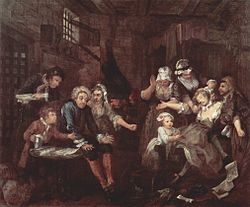http://en.wikipedia.org/wiki/A_Rake's_Progress
A rakes progress is a series of 8 paintings and etchings by William Hogarth. The paintings show the down fall of a mans life and shows his life getting slowly worst. At first i thought that the series was called a rake's progress because the man that the paintings were about was called Tom Rakewell but as i then researched more i found that a rake means, it is an old fashioned term for a "womanizer".
Tom Rake well is a rich merchants son who is enganged to be married to his pregnant fiancee Sarah. He leaves his pregnant fiancee and falls into a life of gambling and prostitutes, he spends all his money and ends up in prison for being in dept. Then ends up being in Bedlam mental asylum.
I chose to focus on the mental hospital.
Bethlam Hospital was designed to treat mentally ill patients from 1247. The patients that survived the hospital and were aloud to leave were given a licence to beg.
A "bedlum begger" is in William Shakespears King Lear, his discuse is also called Tom like in a Rakes Progress, he is described to only have a blanket as his possesion.
http://en.wikipedia.org/wiki/King_Lear
In the eight painting Tom Rakewell is in Bedlam Hospital. Two higher class woman in the background are paying visitiors as the hospital was open to the public. This then made me think how much times have changed and how devided the classes were. The rich people were coming in to see the poor people, when in WW2 the Queens mother in law was admitted to a mental hospital and was treated and seen by people lower than her.
http://www.dailymail.co.uk/news/article-1224189/Caged-human-zoo-The-shocking-story-young-pygmy-warrior-monkey-house--fuelled-Hitlers-twisted-beliefs.html
Depictions
 | In the first painting, Tom has come into his fortune on the death of his miserly father. While the servants mourn, he is being measured for new clothes. He is also rejecting the hand of his pregnant fiancée, Sarah Young, whom he had promised to marry (she is holding his ring and her mother is holding his love letters). He will pay her off, but it is clear that she still loves him. |
 | In the second painting, Tom is at his morning levée in London, attended by musicians and other hangers-on all dressed in expensive costumes. Surrounding Tom from left to right: a music master at a harpsichord, who was supposed to represent George Frideric Handel; a fencing master; a quarterstaff instructor; a dancing master with a violin; a landscape gardener Charles Bridgeman; an ex-soldier offering to be a bodyguard; a bugler of a fox hunt club. At lower right is a jockey with a silver trophy. The quarterstaff instructor looks disapprovingly on both the fencing and dancing masters. Both masters appear to be in the "French" style, which was a subject Hogarth loathed. |
 | The third painting depicts a wild party or orgy underway at a brothel. The whores are stealing the drunken Tom's watch. On the floor is a night watchman's staff and lantern. The scene takes place at the Rose Tavern, a famous brothel in Covent Garden. The prostitutes have black spots on their faces to cover syphilitic sores. |
 | In the fourth, he narrowly escapes arrest for debt by Welsh bailiffs (as signified by the leeks, a Welsh emblem, in their hats) as he travels in a sedan chair to a party at St. James's Palace to celebrate Queen Caroline's birthday on Saint David's Day (Saint David is the patron saint of Wales). On this occasion he is saved by the intervention of Sarah Young, the girl he had earlier rejected; she is apparently a dealer in millinery. In comic relief, a man filling a street lantern spills the oil on Tom's head. This is a sly reference to how blessings on a person were accompanied by oil poured on the head. In this case the "blessing" being the "saving" of Tom by Sarah, although Rakewell, being a rake, will not take the moral lesson to heart. In the engraved version, lighting flashes in the sky and a young pickpocket has just emptied Tom's pocket. The painting, however, shows the young thief stealing Tom's cane and has no lightning. |
 | In the fifth, Tom attempts to salvage his fortune by marrying a rich but aged and ugly old maid at St Marylebone. In the background Sarah arrives holding their child while her indignant mother struggles with a guest. |
 | The sixth painting shows Tom pleading for the assistance of the Almighty in a gambling den at Soho's White Club after losing his "new fortune." Neither he nor the other obsessive gamblers seem to have noticed a fire breaking out behind them. |
 | All is lost by the seventh painting, and Tom is incarcerated in the notorious Fleet debtor's prison. He ignores the distress of both his angry new (old) wife and faithful Sarah, who cannot help him this time. Both the beer-boy and the jailer demand money from him. Tom begins to go mad, as indicated by both a telescope for celestial observation poking out of the barred window and an alchemy experiment in the background. Besides Tom is a rejected play; another inmate is writing a pamphlet on how to solve the National debt. Above the bed at right is an apparatus for wings, which is more clearly seen in the engraved version at the left. |
 | Finally insane and violent, in the eighth painting he ends his days in Bethlehem Hospital (Bedlam), London's celebrated mental asylum. Only Sarah Young is there to comfort him, but Rakewell continues to ignore her. While some of the details in these pictures may appear disturbing to modern eyes, they were commonplace in Hogarth's day. For example, the fashionably dressed women in this last painting have come to the asylum as a social occasion, to be entertained by the bizarre antics of the inmates |
No comments:
Post a Comment